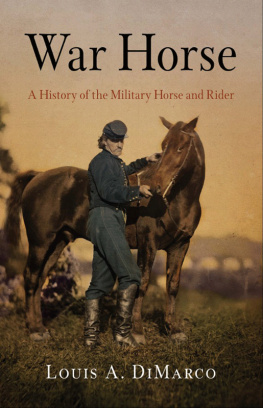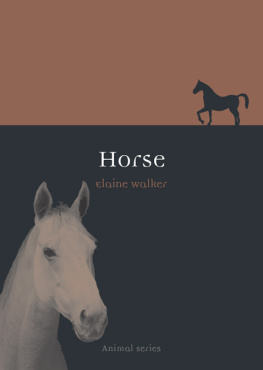CAROLYN WILLEKES holds degrees in classical studies from the University of Calgary and the University of Guelph. Her recent publications include Horse Racing and Chariot Racing, co-authored with Sinclair Bell, in The Oxford Handbook of Animals in Classical Thought and Life (2013), and Equine Aspects of Alexander the Greats Macedonian Cavalry, in Greece, Macedon and Persia: Studies in Social, Political and Military History (2015).
The Horse in the Ancient World is aimed at a broad audience. Its unusual strength lies in Carolyn Willekes? attractive combination of academic expertise with considerable practical experience. This has produced a work of sound scholarship which is also accessible to the general reader. It should be an invaluable companion to classical specialists and equine enthusiasts alike; it is of good quality, and fills a gap in the current literature.
IAIN G. SPENCE, former Associate Professor of Classics and Ancient History, University of New England, New South Wales, author of The Cavalry of Classical Greece: A Social and Military History
Carolyn Willekes' book is a most welcome addition to a growing list of publications devoted to ancient equestrian and cavalry studies. It is a richly informative work, giving ample evidence of the author's long personal experience with horses and equestrian activity. Throughout her book, Willekes stresses the close relationship between humans and horses since the domestication of the latter in the fourth millennium BCE . Her chapters on the evolution of the horse and horse riding, and her clear categorization of horse types, are clear, concise and persuasive. Willekes' book should appeal to an audience far broader than just horse enthusiasts: she covers the use of the horse in war; in art (for example, offering a provocative interpretation of the Parthenon frieze); and in sports. She also includes lengthy translated excerpts of ancient Greek and Roman writers on what we would call equine conformation. All in all, this is an enjoyable, well-researched and nicely balanced introduction to the subject.
GLENN R. BUGH, Associate Professor of Classical Studies and Byzantine History, Virginia Tech, author of The Horsemen of Athens and editor of The Cambridge Companion to the Hellenistic World
THE HORSE IN
THE ANCIENT
WORLD
From Bucephalus to the Hippodrome
CAROLYN WILLEKES

Published in 2016 by
I.B.Tauris & Co. Ltd
London New York
www.ibtauris.com
Copyright 2016 Carolyn Willekes
The right of Carolyn Willekes to be identified as the author of this work has been asserted by the author in accordance with the Copyright, Designs and Patents Act 1988.
All rights reserved. Except for brief quotations in a review, this book, or any part thereof, may not be reproduced, stored in or introduced into a retrieval system, or transmitted, in any form or by any means, electronic, mechanical, photocopying, recording or otherwise, without the prior written permission of the publisher.
Every attempt has been made to gain permission for the use of the images in this book. Any omissions will be rectified in future editions.
References to websites were correct at the time of writing.
Library of Classical Studies 10
ISBN: 978 1 78453 366 3
eISBN: 978 1 78672 009 2
ePDF: 978 1 78673 009 1
A full CIP record for this book is available from the British Library
A full CIP record is available from the Library of Congress
Library of Congress Catalog Card Number: available
For my parents: gratias tibi ago
CONTENTS
LIST OF ILLUSTRATIONS
FIGURES
The anatomy of the horse.
The equine skeleton.
On onager hunt as depicted on a mosaic from Henchir Toungar, c.240 CE . Located in the Bardo Museum. Credit: Sean Leatherbury/Manar al-Athar, Manar al-Athar.
Upper Palaeolithic bton perc with a horse-head engraving, c.15,000 BCE . Credit: With permission of the Royal Ontario Museum, ROM.
Trefoil oinochoe attributed to the Painter of the Roaring Lions with a late geometric representation of a horse, c.740 BCE . Credit: National Archaeological Museum, Athens, Hellenic Ministry of Culture, Education and Religious Affairs/Archaeological Receipts Fund. Photographer: C. Willekes.
Black-figure Skyphos attributed to the Painter of Philadelphia, c.500 BCE . Credit: National Archaeological Museum, Athens, Hellenic Ministry of Culture, Education and Religious Affairs/Archaeological Receipts Fund. Photographer: C. Willekes.
Sketch detail from the west frieze of the Parthenon. Credit: Dover Pictura.
The author riding the Berber gelding Magnus. Credit: C. Willekes.
Early horse skeleton Mesohippus bairdii. Credit: With permission of the Royal Ontario Museum, ROM.
Ancestral horse skeleton (cast) Merychippus. Credit: With permission of the Royal Ontario Museum, ROM.
Harem band of Przewalski horses in Hustai National Park, Mongolia. Credit: C. Willekes.
Horses maintaining rank and order in a herd. Credit: Dover Pictura.
Detail of the Nike brand on the Artemision horse. Credit: National Archaeological Museum, Athens, Hellenic Ministry of Culture, Education and Religious Affairs/Archaeological Receipts Fund. Photographer: C. Willekes.
Sketches of the equine leg by Leonardo Da Vinci. Credit: Dover Pictura.
Sketches of an equine with emphasis on the chest by Leonardo Da Vinci. Credit: Dover Pictura.
Sketches of the equine hind end by Leonardo Da Vinci. Credit: Dover Pictura.
Bactrian camels, horses and bovines grazing in central Mongolia. Credit: C. Willekes.
Mongolian nomads performing the afternoon milking. Central Mongolia. Credit: C. Willekes.
Traditional Mongolian gers/yurts. Central Mongolia. Credit: C. Willekes.
Silver belt plaque in the shape of a crouching horse. From northern China, thirdfirst century BCE . Credit: The Metropolitan Museum of Art, Gift of the Ernest Erickson Foundation, The Metropolitan Museum of Art/Images for Academic Publishing.
A typical Central Asian/Steppe horse in traditional Mongolian tack. Credit: C. Willekes.
The rolling, grassy hills surrounding the Hittite Capital of Hattusas (modern Boazkale) in Anatolia. Credit: C. Willekes.
Nesaean horses pulling the royal chariots, c.sixthfifth century BCE . The Eastern Apadana Staircase at Persepolis, Iran. Credit: Bryn Mawr College (MJM-03897), photographed by Machteld Johanna Melink, Bryn Mawr College/Images for Academic Publishing.
Artists sketch of a horse, c.664610 BCE . From Deir el-Bahri, Thebes. Credit: The Metropolitan Museum of Art, Rogers Fund (23.3.33), The Metropolitan Museum of Art/Images for Academic Publishing.
The author and Kelebek outside the Roman gates of ancient Nicea (modern Iznik). Credit: C. Willekes.
The grassy meadows of Pylos in south-western Greece. Credit: C. Willekes.125
The stables of Poseidon. Black-figure kylix attributed to the Amasis Painter, c.540 BCE . Credit: The Metropolitan Museum of Art, Gift of the Norbert Schimmel Trust, 1989 (1989.281.62), The Metropolitan Museum of Art/Images for Academic Publishing.
Depiction of a four-horse chariot. Attic black-figure amphora by the Bologna Painter, c.510 BCE . Credit: National Archaeological Museum, Athens, Hellenic Ministry of Culture, Education and Religious Affairs/Archaeological Receipts Fund. Photographer: C. Willekes.
A Patras Mountain Horse living on Crete. Credit: C. Willekes.
Detail of a fallen horse and rider from the Ludovisi Sarcophagus, c.260 CE . Museo Nazionale Romano Palazzo Altemps. Credit: With permission of the Ministry of Cultural Heritage and Activities
Next page









